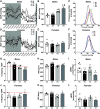Parental obesity alters offspring blood pressure regulation and cardiovascular responses to stress: role of P2X7R and sex differences
- PMID: 35318854
- PMCID: PMC9018009
- DOI: 10.1152/ajpregu.00300.2021
Parental obesity alters offspring blood pressure regulation and cardiovascular responses to stress: role of P2X7R and sex differences
Abstract
We examined the impact of parental obesity on offspring blood pressure (BP) regulation and cardiovascular responses to stress. Offspring from normal (N) diet-fed C57BL/6J parents were fed either N (NN) or a high-fat (H) diet (NH) from weaning until adulthood. Offspring from obese H diet-fed parents were also fed N (HN) or H diet (HH). Body weight, calorie intake, and fat mass were measured at 22 wk of age when cardiovascular phenotyping was performed. Male and female HH offspring were 15% heavier than NH and 70% heavier than NN offspring. Male HH and HN offspring had elevated BP (121 ± 2 and 115 ± 1 mmHg, by telemetry) compared with male NH and NN offspring (108 ± 6 and 107 ± 3 mmHg, respectively) and augmented BP responses to angiotensin II, losartan, and hexamethonium. Male HH and HN offspring also showed increased BP responses to air-jet stress (37 ± 2 and 38 ± 2 mmHg) compared with only 24 ± 3 and 25 ± 3 mmHg in NH and NN offspring. Baseline heart rate (HR) and HR responses to air-jet stress were similar among groups. In females, BP and cardiovascular responses to stress were similar among all offspring. Male H diet-fed offspring from obese H diet-fed purinoreceptor 7-deficient (HH-P2X7R-KO) parents had normal BP that was similar to control NN-P2X7R-KO offspring from lean parents. These results indicate that parental obesity leads to increased BP and augmented BP responses to stress in their offspring in a sex-dependent manner, and the impact of parental obesity on male offspring BP regulation is markedly attenuated in P2X7R-KO mice.
Keywords: baroreflex; developmental programming; heart rate variability; hypertension; purinoreceptor.
Conflict of interest statement
No conflicts of interest, financial or otherwise, are declared by the authors.
Figures







Similar articles
-
Sex differences in weight gain, blood pressure control, and responses to melanocortin-4 receptor antagonism in offspring from lean and obese parents.Am J Physiol Regul Integr Comp Physiol. 2023 Oct 1;325(4):R401-R410. doi: 10.1152/ajpregu.00106.2023. Epub 2023 Jul 31. Am J Physiol Regul Integr Comp Physiol. 2023. PMID: 37519251 Free PMC article.
-
Parental obesity predisposes offspring to kidney dysfunction and increased susceptibility to ischemia-reperfusion injury in a sex-dependent manner.Am J Physiol Renal Physiol. 2024 May 1;326(5):F727-F736. doi: 10.1152/ajprenal.00294.2023. Epub 2024 Mar 21. Am J Physiol Renal Physiol. 2024. PMID: 38511219 Free PMC article.
-
Maternal high-fat diet acts on the brain to induce baroreflex dysfunction and sensitization of angiotensin II-induced hypertension in adult offspring.Am J Physiol Heart Circ Physiol. 2018 May 1;314(5):H1061-H1069. doi: 10.1152/ajpheart.00698.2017. Epub 2018 Jan 26. Am J Physiol Heart Circ Physiol. 2018. PMID: 29373045 Free PMC article.
-
Effects of maternal high-fat diet and statin treatment on bone marrow endothelial progenitor cells and cardiovascular risk factors in female mice offspring fed a similar diet.Nutrition. 2017 Mar;35:6-13. doi: 10.1016/j.nut.2016.10.011. Epub 2016 Oct 21. Nutrition. 2017. PMID: 28241992
-
Sex differences in the development of angiotensin II-induced hypertension in conscious mice.Am J Physiol Heart Circ Physiol. 2005 May;288(5):H2177-84. doi: 10.1152/ajpheart.00969.2004. Epub 2004 Dec 30. Am J Physiol Heart Circ Physiol. 2005. PMID: 15626687
Cited by
-
Parental obesity predisposes male and female offspring to exacerbated cardiac dysfunction and increased mortality after myocardial infarction.Am J Physiol Heart Circ Physiol. 2025 May 1;328(5):H1039-H1050. doi: 10.1152/ajpheart.00827.2024. Epub 2025 Mar 20. Am J Physiol Heart Circ Physiol. 2025. PMID: 40112092 Free PMC article.
-
Sex differences in weight gain, blood pressure control, and responses to melanocortin-4 receptor antagonism in offspring from lean and obese parents.Am J Physiol Regul Integr Comp Physiol. 2023 Oct 1;325(4):R401-R410. doi: 10.1152/ajpregu.00106.2023. Epub 2023 Jul 31. Am J Physiol Regul Integr Comp Physiol. 2023. PMID: 37519251 Free PMC article.
-
Loss of hepatic PPARα in mice causes hypertension and cardiovascular disease.Am J Physiol Regul Integr Comp Physiol. 2023 Jul 1;325(1):R81-R95. doi: 10.1152/ajpregu.00057.2023. Epub 2023 May 22. Am J Physiol Regul Integr Comp Physiol. 2023. PMID: 37212551 Free PMC article.
-
Epigenetic modifications and fetal programming: Molecular mechanisms to control hypertension inheritance.Biochem Pharmacol. 2023 Feb;208:115412. doi: 10.1016/j.bcp.2023.115412. Epub 2023 Jan 9. Biochem Pharmacol. 2023. PMID: 36632959 Free PMC article. Review.
-
Parental obesity predisposes offspring to kidney dysfunction and increased susceptibility to ischemia-reperfusion injury in a sex-dependent manner.Am J Physiol Renal Physiol. 2024 May 1;326(5):F727-F736. doi: 10.1152/ajprenal.00294.2023. Epub 2024 Mar 21. Am J Physiol Renal Physiol. 2024. PMID: 38511219 Free PMC article.
References
-
- Martos-Moreno GÁ, Martinez-Villanueva J, González-Leal R, Barrios V, Sirvent S, Hawkins F, Chowen JA, Argente J. Ethnicity strongly influences body fat distribution determining serum adipokine profile and metabolic derangement in childhood obesity. Front Pediatr 8: 551103, 2020. doi:10.3389/fped.2020.551103. - DOI - PMC - PubMed
Publication types
MeSH terms
Grants and funding
LinkOut - more resources
Full Text Sources
Medical
Molecular Biology Databases
Research Materials

